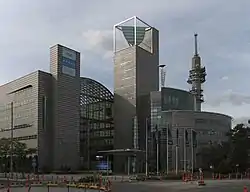Uusimaa
Uusimaa (Finnish: [ˈuːsimɑː]; Swedish: Nyland, Finland Swedish: [ˈnyːlɑnd], Sweden Swedish: [ˈny̌ːland]; both lit. "new land") is a region of Finland. It borders the regions of Southwest Finland, Tavastia Proper (Kanta-Häme), Päijänne Tavastia (Päijät-Häme), and Kymenlaakso. Finland's capital and largest city, Helsinki, along with the surrounding Greater Helsinki area, are both contained in the region, and Uusimaa is Finland's most populous region. The population of Uusimaa is 1,638,469.
Uusimaa
Uudenmaan maakunta landskapet Nyland | |
|---|---|
 Flag  Coat of arms | |
| Anthem: Uusmaalaisten laulu | |
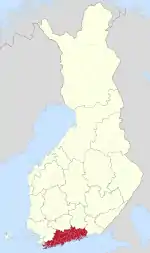 Uusimaa in Red on a map of Finland | |
| Country | Finland |
| Historical province | Uusimaa |
| Capital | Helsinki |
| Government | |
| • Regional Mayor | Ossi Savolainen |
| • President of the Council | Eero Heinäluoma |
| Area | |
| • Total | 9,568 km2 (3,694 sq mi) |
| Population (December 31, 2019) | |
| • Total | 1,689,725 |
| • Density | 176/km2 (460/sq mi) |
| Demonym(s) | uusmaalainen (Finnish) nylänning (Swedish) |
| Time zone | UTC+2 (EET) |
| • Summer (DST) | UTC+3 (EEST) |
| ISO 3166 code | FI-18 |
| NUTS | 181 |
| – HDI (2018) | 0.946[1] very high |
| Regional bird | Blackbird |
| Regional fish | Zander |
| Regional flower | Windflower |
| Regional animal | European hedgehog |
| Regional stone | Hornblende |
| Website | uudenmaanliitto.fi |
History
The place name of Nuuksio derives from Sami word njukča which means Swan.[2] Later Finns proper and Tavastians inhabited the area. Some place names have traces of Tavastian village names, like Konala which likely derives from older Tavastian village name Konhola.[3] Estonians inhabited the region to a smaller extent, specifically for seasonal fishing.[4]
Swedish colonisation of coastal Uusimaa started after the second crusade to Finland in the 13th century.[5][6] The colonisation was part of converting pagan areas to Catholicism. Eastern Uusimaa had its first Christian Swedish colonialists earlier than the western part, which got its colonialists in one mass transfer of people to Porvoo in the 14th century. The colonisation was supported by the Swedish kingdom and the immigrants were provided with grain seeds and cattle. They also got a four-year tax exemption from the crown.[4] All the Swedish placenames of Uusimaa date back to this period.[7]
The names Uusimaa and Nyland meaning “new land” in English derives from the Swedish colonisation era. The Swedish-language name Nyland appears in the documents from the 14th century. The Finnish-language name Uusimaa appears for the first time in 1548 as Wsimaa in the first translation of the New Testament to Finnish by Mikael Agricola.[8] Much of Uusimaa is literally new - it has risen off Baltic sea due to post-glacial rebound.
The Finnish provinces were ceded to Imperial Russia in the War of Finland in 1809. After this, Uusimaa became the Province of Uusimaa in the old lääni system. From 1997 to 2010, Uusimaa was a part of the Province of Southern Finland. In 1994 it was divided into the regions of Uusimaa and Eastern Uusimaa, but in 2011 the two regions were merged as Uusimaa.
March 28, 2020, Uusimaa was isolated from the rest of Finland due to the worst coronavirus outbreak in the region.[9]
Economy
The Gross domestic product (GDP) of the region was 91.2 billion € in 2018, accounting for 38.9% of Finnish economic output. GDP per capita adjusted for purchasing power was 43,500 € or 144% of the EU27 average in the same year. The GDP per employee was 120% of the EU average.[10]
Languages
Uusimaa is a bilingual region, with municipalities both bilingual in Finnish and Swedish, and monolingual in Finnish. Uusimaa's coastal areas tend to be Swedish-speaking. The traditional regional dialects of Swedish (nyländska) are currentlymostly spoken in Eastern Uusimaa, while in the rest of the Uusimaa Swedish dialect has become more standardised.
The Finnish-speaking population started to grow when the capital of the Grand Duchy of Finland was moved from Turku to Helsinki by Emperor of Russia Alexander I in 1812, and the region attracted settlers from other parts of Finland. Helsinki's slang first evolved in the late 19th century. 8,5% of population of the region speak the Swedish language natively.
Regional council
The regional council is the main governing body for region and focuses primarily on urban planning. Like all regional councils, it is mandated by law.
Municipalities
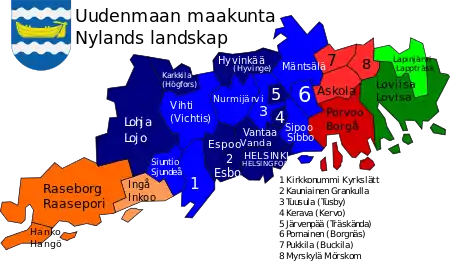
The region of Uusimaa is made up of 26 municipalities, of which 13 have city status (marked in bold).[12]
|
Helsinki Sub-region:
|
Raseborg Sub-region:
Loviisa Sub-region:
Porvoo Sub-region:
|
Gallery
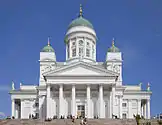 Helsinki Cathedral, a symbol of the capital
Helsinki Cathedral, a symbol of the capital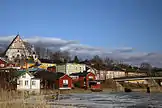 Porvoo Old Town
Porvoo Old Town Nurmijärvi Church
Nurmijärvi Church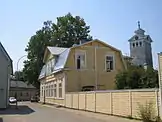 Ekenäs Old Town
Ekenäs Old Town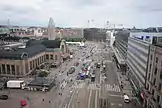 A view of central Helsinki with the Railway Station
A view of central Helsinki with the Railway Station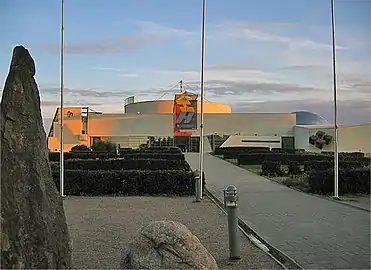
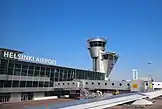 Helsinki-Vantaa Airport in Vantaa, the largest airport in Finland
Helsinki-Vantaa Airport in Vantaa, the largest airport in Finland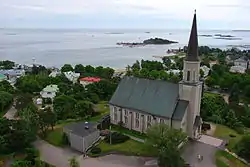 A view of Hanko, the southernmost town in Finland
A view of Hanko, the southernmost town in Finland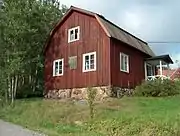 The house where Aleksis Kivi born, Nurmijärvi; an example of early 19th century housing in the area
The house where Aleksis Kivi born, Nurmijärvi; an example of early 19th century housing in the area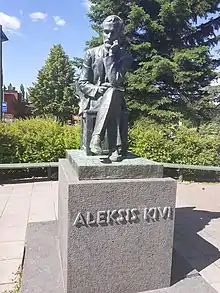 Aleksis Kivi's statue in the Nurmijärvi church village
Aleksis Kivi's statue in the Nurmijärvi church village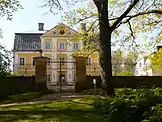 Fagervik Manor, Ingå; there are plenty of manor houses in the area
Fagervik Manor, Ingå; there are plenty of manor houses in the area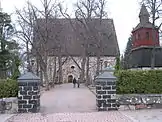 The medieval, late 15th century Lohja Church is one of the biggest of its kind in Finland
The medieval, late 15th century Lohja Church is one of the biggest of its kind in Finland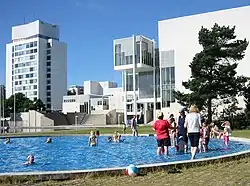
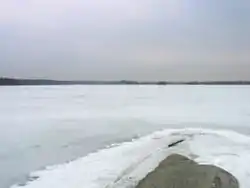 Lake Bodom in Oittaa, Espoo
Lake Bodom in Oittaa, Espoo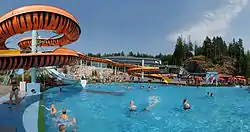 Serena Waterpark in Lahnus, Espoo
Serena Waterpark in Lahnus, Espoo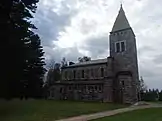 Pornainen Church in Kirveskoski, Pornainen
Pornainen Church in Kirveskoski, Pornainen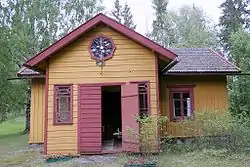 The childhood home of Johannes Linnankoski in Askola
The childhood home of Johannes Linnankoski in Askola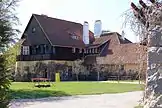 Hvitträsk, a residence in national romantic style in Kirkkonummi, now a museum
Hvitträsk, a residence in national romantic style in Kirkkonummi, now a museum
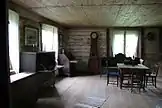 A rural 19th century peasant interior in Lohilampi Museum, Sammatti
A rural 19th century peasant interior in Lohilampi Museum, Sammatti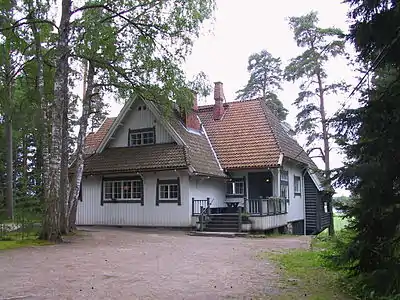 Ainola, Home of Jean Sibelius, in Järvenpää
Ainola, Home of Jean Sibelius, in Järvenpää Loviisa Town Hall
Loviisa Town Hall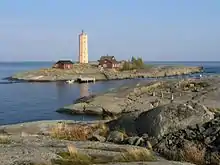 A view of Finnish Gulf in Porvoo Archipelago with Söderskär Lighthouse
A view of Finnish Gulf in Porvoo Archipelago with Söderskär Lighthouse_in_Tammisaari_Finland.jpg.webp) Raseborg Castle from the 14th century, partly ruined
Raseborg Castle from the 14th century, partly ruined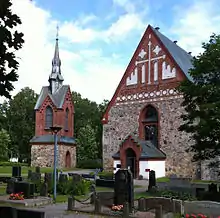 Church of St. Lawrence in Vantaa, the oldest building in the capital region
Church of St. Lawrence in Vantaa, the oldest building in the capital region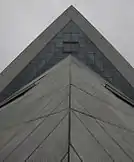 Hyvinkää Church, an example of modern Finnish church architecture
Hyvinkää Church, an example of modern Finnish church architecture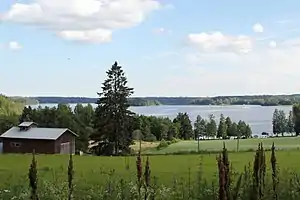 A rural landscape in Pusula with Lake Hiidenvesi
A rural landscape in Pusula with Lake Hiidenvesi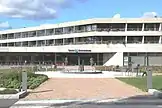 Scandic Siuntio, hotel and spa in Siuntio
Scandic Siuntio, hotel and spa in Siuntio Kerava town centre tower blocks
Kerava town centre tower blocks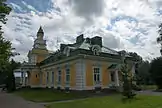 Hirvihaara Manor, Mäntsälä
Hirvihaara Manor, Mäntsälä Karkkila, a small town in north of the region
Karkkila, a small town in north of the region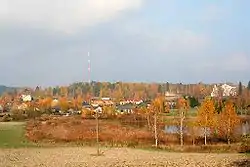 Myrskylä village in the municipality by same name (also in north of the region)
Myrskylä village in the municipality by same name (also in north of the region) Suomenlinna Fortress with the city of Helsinki in the background
Suomenlinna Fortress with the city of Helsinki in the background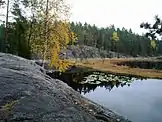
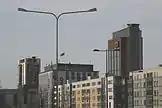 Leppävaara, one of Espoo's centres
Leppävaara, one of Espoo's centres
Media
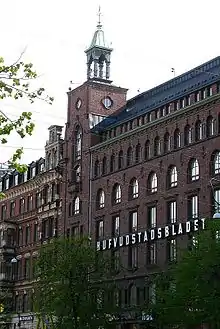
Newspapers
The largest subscription newspapers published in the region are Helsingin Sanomat and Hufvudstadsbladet in Helsinki, Aamuposti in Hyvinkää, Länsi-Uusimaa in Lohja, Loviisan Sanomat and Östra Nyland in Loviisa, Uusimaa and Borgåbladet in Porvoo, Västra Nyland in Raseborg, and Keski-Uusimaa in Tuusula. Also two popular tabloid newspapers, Iltalehti and Ilta-Sanomat, are published there.
Radio stations
Yle's local radio stations in the western part of the region are Finnish-language Ylen läntinen and Swedish-language Yle Vega Västnyland, in the Capital Region Finnish-language Yle Radio Suomi Helsinki and Swedish-language Yle Vega Huvudstadsregionen, and in the eastern part Finnish-language Yle Radio Itä-Uusimaa and Swedish-language Yle Vega Östnyland.
Politics
Results of the 2019 Finnish parliamentary election in Uusimaa (consisting of two constituencies, named Helsinki and Uusimaa):
- National Coalition Party 21.28%
- Green League 17.62%
- Social Democratic Party 16.04%
- Finns Party 14.37%
- Swedish People's Party 7.51%
- Left Alliance 7.42%
- Centre Party 4.97%
- Movement Now 4.11%
- Christian Democrats 2.38%
- Blue Reform 1.24%
- Seven Star Movement 0.43%
- Other parties 2.63%
Heraldry
The coat of arms of the province is Azure, a boat Or between two fesses wavy Argent (a golden boat which is a symbol for the coastal areas, and two silver wavy fesses which are the symbol for rivers.)
Uusimaa received its coat of arms at the end of the 16th century. There is an image of the coat of arms made in 1599. In 1997, the traditional coat of arms became the official coat of arms of the region.
See also
References
- "Sub-national HDI – Area Database – Global Data Lab". hdi.globaldatalab.org. Retrieved September 13, 2018.
- Tarkiainen, Kari (2010). Ruotsin itämaa. Helsinki: Svenska litteratursällskapet i Finland. p. 120.
- Terhi Ainiala, Minna Saarelma ja Paula Sjöblom (2008). Nimistötutkimuksen perusteet. Helsinki: Suomalaisen kirjallisuuden seura. p. 66.
- Tarkiainen, Kari (2010). Ruotsin itämaa. Helsinki: Svenska litteratursällskapet i Finland. pp. 119–136.
- V.-P. Suhonen and Janne Heinonen (2011). "Helsingin keskiaikaiset ja uuden ajan alun kylänpaikat 2011, Inventointiraportti 2011. Museovirasto" (PDF).
- Tarkiainen, Kari (2010). Ruotsin itämaa. Porvoo: Svenska litteratussällskapet i Finland. pp. 122–125. ISBN 9789515832122.
- Terhi Ainiala, Minna Saarelma ja Paula Sjöblom (2008). Nimistötutkimuksen perusteet. Helsinki: Suomalaisen kirjallisuuden seura. p. 68.
- Uusimaa Regional Council (May 12, 2010). "Nytt Land, Nylands historia" (in Swedish). Archived from the original on July 16, 2011. Retrieved May 17, 2010.
- Checkpoints ready: Parliament approves government plans to isolate Uusimaa
- "Regional GDP per capita ranged from 30% to 263% of the EU average in 2018". Eurostat.
- "Väestö". Stat.fi: Statistics – Population structure. Statistics Finland. 2017. Retrieved November 26, 2018.
- "Regional Council – Uudenmaan liitto". www.uudenmaanliitto.fi. March 5, 2013. Retrieved January 31, 2017.
External links
| Wikimedia Commons has media related to Uusimaa. |
| Wikivoyage has a travel guide for Uusimaa. |
